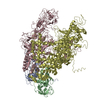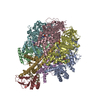+ データを開く
データを開く
- 基本情報
基本情報
| 登録情報 | データベース: EMDB / ID: EMD-6991 | ||||||||||||
|---|---|---|---|---|---|---|---|---|---|---|---|---|---|
| タイトル | Structure of the human PKD1/PKD2 complex | ||||||||||||
 マップデータ マップデータ | None | ||||||||||||
 試料 試料 |
| ||||||||||||
 キーワード キーワード | Asymmetric complex / polycystic kidney disease / MEMBRANE PROTEIN | ||||||||||||
| 機能・相同性 |  機能・相同性情報 機能・相同性情報metanephric distal tubule morphogenesis / detection of nodal flow / metanephric smooth muscle tissue development / metanephric cortex development / metanephric cortical collecting duct development / metanephric distal tubule development / polycystin complex / mesonephric tubule development / mesonephric duct development / metanephric part of ureteric bud development ...metanephric distal tubule morphogenesis / detection of nodal flow / metanephric smooth muscle tissue development / metanephric cortex development / metanephric cortical collecting duct development / metanephric distal tubule development / polycystin complex / mesonephric tubule development / mesonephric duct development / metanephric part of ureteric bud development / determination of liver left/right asymmetry / renal tubule morphogenesis / metanephric ascending thin limb development / HLH domain binding / lung epithelium development / mitocytosis / lymph vessel morphogenesis / basal cortex / metanephric mesenchyme development / metanephric S-shaped body morphogenesis / renal artery morphogenesis / metanephric proximal tubule development / positive regulation of inositol 1,4,5-trisphosphate-sensitive calcium-release channel activity / migrasome / calcium-independent cell-matrix adhesion / Wnt receptor activity / cilium organization / VxPx cargo-targeting to cilium / genitalia development / establishment of epithelial cell polarity / centrosome duplication / detection of mechanical stimulus / calcium-induced calcium release activity / regulation of calcium ion import / cation channel complex / muscle alpha-actinin binding / response to fluid shear stress / placenta blood vessel development / voltage-gated monoatomic ion channel activity / Golgi-associated vesicle membrane / cellular response to hydrostatic pressure / outward rectifier potassium channel activity / cellular response to fluid shear stress / metanephric collecting duct development / voltage-gated monoatomic cation channel activity / digestive tract development / non-motile cilium / cellular response to osmotic stress / actinin binding / motile cilium / transcription regulator inhibitor activity / cartilage development / determination of left/right symmetry / aorta development / inorganic cation transmembrane transport / neural tube development / ciliary membrane / voltage-gated sodium channel activity / protein heterotetramerization / skin development / embryonic placenta development / branching involved in ureteric bud morphogenesis / cartilage condensation / negative regulation of G1/S transition of mitotic cell cycle / branching morphogenesis of an epithelial tube / spinal cord development / heart looping / homophilic cell adhesion via plasma membrane adhesion molecules / negative regulation of ryanodine-sensitive calcium-release channel activity / voltage-gated potassium channel activity / cytoplasmic side of endoplasmic reticulum membrane / regulation of G1/S transition of mitotic cell cycle / cell surface receptor signaling pathway via JAK-STAT / potassium channel activity / lateral plasma membrane / anatomical structure morphogenesis / sodium ion transmembrane transport / voltage-gated calcium channel activity / regulation of cell adhesion / monoatomic cation channel activity / basal plasma membrane / regulation of proteasomal protein catabolic process / cellular response to cAMP / release of sequestered calcium ion into cytosol / regulation of mitotic spindle organization / potassium ion transmembrane transport / calcium channel complex / cellular response to calcium ion / cytoskeletal protein binding / protein export from nucleus / cell-matrix adhesion / ciliary basal body / liver development / kidney development / establishment of localization in cell / lumenal side of endoplasmic reticulum membrane / phosphoprotein binding / calcium ion transmembrane transport / protein tetramerization / cellular response to reactive oxygen species 類似検索 - 分子機能 | ||||||||||||
| 生物種 |  Homo sapiens (ヒト) Homo sapiens (ヒト) | ||||||||||||
| 手法 | 単粒子再構成法 / クライオ電子顕微鏡法 / 解像度: 3.6 Å | ||||||||||||
 データ登録者 データ登録者 | Su Q / Hu F / Ge X / Lei J / Yu S / Wang T / Zhou Q / Mei C / Shi Y | ||||||||||||
| 資金援助 |  中国, 3件 中国, 3件
| ||||||||||||
 引用 引用 |  ジャーナル: Science / 年: 2018 ジャーナル: Science / 年: 2018タイトル: Structure of the human PKD1-PKD2 complex. 著者: Qiang Su / Feizhuo Hu / Xiaofei Ge / Jianlin Lei / Shengqiang Yu / Tingliang Wang / Qiang Zhou / Changlin Mei / Yigong Shi /  要旨: Mutations in two genes, and , account for most cases of autosomal dominant polycystic kidney disease, one of the most common monogenetic disorders. Here we report the 3.6-angstrom cryo-electron ...Mutations in two genes, and , account for most cases of autosomal dominant polycystic kidney disease, one of the most common monogenetic disorders. Here we report the 3.6-angstrom cryo-electron microscopy structure of truncated human PKD1-PKD2 complex assembled in a 1:3 ratio. PKD1 contains a voltage-gated ion channel (VGIC) fold that interacts with PKD2 to form the domain-swapped, yet noncanonical, transient receptor potential (TRP) channel architecture. The S6 helix in PKD1 is broken in the middle, with the extracellular half, S6a, resembling pore helix 1 in a typical TRP channel. Three positively charged, cavity-facing residues on S6b may block cation permeation. In addition to the VGIC, a five-transmembrane helix domain and a cytosolic PLAT domain were resolved in PKD1. The PKD1-PKD2 complex structure establishes a framework for dissecting the function and disease mechanisms of the PKD proteins. | ||||||||||||
| 履歴 |
|
- 構造の表示
構造の表示
| ムービー |
 ムービービューア ムービービューア |
|---|---|
| 構造ビューア | EMマップ:  SurfView SurfView Molmil Molmil Jmol/JSmol Jmol/JSmol |
| 添付画像 |
- ダウンロードとリンク
ダウンロードとリンク
-EMDBアーカイブ
| マップデータ |  emd_6991.map.gz emd_6991.map.gz | 58.7 MB |  EMDBマップデータ形式 EMDBマップデータ形式 | |
|---|---|---|---|---|
| ヘッダ (付随情報) |  emd-6991-v30.xml emd-6991-v30.xml emd-6991.xml emd-6991.xml | 14.5 KB 14.5 KB | 表示 表示 |  EMDBヘッダ EMDBヘッダ |
| 画像 |  emd_6991.png emd_6991.png | 238.9 KB | ||
| Filedesc metadata |  emd-6991.cif.gz emd-6991.cif.gz | 6.4 KB | ||
| アーカイブディレクトリ |  http://ftp.pdbj.org/pub/emdb/structures/EMD-6991 http://ftp.pdbj.org/pub/emdb/structures/EMD-6991 ftp://ftp.pdbj.org/pub/emdb/structures/EMD-6991 ftp://ftp.pdbj.org/pub/emdb/structures/EMD-6991 | HTTPS FTP |
-関連構造データ
| 関連構造データ |  6a70MC  6992C C: 同じ文献を引用 ( M: このマップから作成された原子モデル |
|---|---|
| 類似構造データ | |
| 電子顕微鏡画像生データ |  EMPIAR-10262 (タイトル: Structure of the human PKD1-PKD2 complex / Data size: 209.8 EMPIAR-10262 (タイトル: Structure of the human PKD1-PKD2 complex / Data size: 209.8 Data #1: Autopicked particles of PKD1/PKD2 complex [picked particles - multiframe - unprocessed]) |
- リンク
リンク
| EMDBのページ |  EMDB (EBI/PDBe) / EMDB (EBI/PDBe) /  EMDataResource EMDataResource |
|---|---|
| 「今月の分子」の関連する項目 |
- マップ
マップ
| ファイル |  ダウンロード / ファイル: emd_6991.map.gz / 形式: CCP4 / 大きさ: 64 MB / タイプ: IMAGE STORED AS FLOATING POINT NUMBER (4 BYTES) ダウンロード / ファイル: emd_6991.map.gz / 形式: CCP4 / 大きさ: 64 MB / タイプ: IMAGE STORED AS FLOATING POINT NUMBER (4 BYTES) | ||||||||||||||||||||||||||||||||||||||||||||||||||||||||||||
|---|---|---|---|---|---|---|---|---|---|---|---|---|---|---|---|---|---|---|---|---|---|---|---|---|---|---|---|---|---|---|---|---|---|---|---|---|---|---|---|---|---|---|---|---|---|---|---|---|---|---|---|---|---|---|---|---|---|---|---|---|---|
| 注釈 | None | ||||||||||||||||||||||||||||||||||||||||||||||||||||||||||||
| ボクセルのサイズ | X=Y=Z: 1.091 Å | ||||||||||||||||||||||||||||||||||||||||||||||||||||||||||||
| 密度 |
| ||||||||||||||||||||||||||||||||||||||||||||||||||||||||||||
| 対称性 | 空間群: 1 | ||||||||||||||||||||||||||||||||||||||||||||||||||||||||||||
| 詳細 | EMDB XML:
CCP4マップ ヘッダ情報:
| ||||||||||||||||||||||||||||||||||||||||||||||||||||||||||||
-添付データ
- 試料の構成要素
試料の構成要素
-全体 : the structure of an asymmetric complex
| 全体 | 名称: the structure of an asymmetric complex |
|---|---|
| 要素 |
|
-超分子 #1: the structure of an asymmetric complex
| 超分子 | 名称: the structure of an asymmetric complex / タイプ: complex / ID: 1 / 親要素: 0 / 含まれる分子: all 詳細: Samples were obtained by co-expression in 293F cells. A complex contains one PKD1 subunit and three PKD2 subunits. |
|---|---|
| 由来(天然) | 生物種:  Homo sapiens (ヒト) Homo sapiens (ヒト) |
| 分子量 | 理論値: 310 KDa |
-分子 #1: Polycystin-2
| 分子 | 名称: Polycystin-2 / タイプ: protein_or_peptide / ID: 1 / コピー数: 3 / 光学異性体: LEVO |
|---|---|
| 由来(天然) | 生物種:  Homo sapiens (ヒト) Homo sapiens (ヒト) |
| 分子量 | 理論値: 66.623406 KDa |
| 組換発現 | 生物種:  HOMO SAPIENS (ヒト) HOMO SAPIENS (ヒト) |
| 配列 | 文字列: MGSAGWSHPQ FEKGGGSGGG SGGSAWSHPQ FEKGSAAAPR VAWAERLVRG LRGLWGTRLM EESSTNREKY LKSVLRELVT YLLFLIVLC ILTYGMMSSN VYYYTRMMSQ LFLDTPVSKT EKTNFKTLSS MEDFWKFTEG SLLDGLYWKM QPSNQTEADN R SFIFYENL ...文字列: MGSAGWSHPQ FEKGGGSGGG SGGSAWSHPQ FEKGSAAAPR VAWAERLVRG LRGLWGTRLM EESSTNREKY LKSVLRELVT YLLFLIVLC ILTYGMMSSN VYYYTRMMSQ LFLDTPVSKT EKTNFKTLSS MEDFWKFTEG SLLDGLYWKM QPSNQTEADN R SFIFYENL LLGVPRIRQL RVRNGSCSIP QDLRDEIKEC YDVYSVSSED RAPFGPRNGT AWIYTSEKDL NGSSHWGIIA TY SGAGYYL DLSRTREETA AQVASLKKNV WLDRGTRATF IDFSVYNANI NLFCVVRLLV EFPATGGVIP SWQFQPLKLI RYV TTFDFF LAACEIIFCF FIFYYVVEEI LEIRIHKLHY FRSFWNCLDV VIVVLSVVAI GINIYRTSNV EVLLQFLEDQ NTFP NFEHL AYWQIQFNNI AAVTVFFVWI KLFKFINFNR TMSQLSTTMS RCAKDLFGFA IMFFIIFLAY AQLAYLVFGT QVDDF STFQ ECIFTQFRII LGDINFAEIE EANRVLGPIY FTTFVFFMFF ILLNMFLAII NDTYSEVKSD LAQQKAEMEL SDLIRK GYH KALVKLKLKK NTVD UniProtKB: Polycystin-2 |
-分子 #2: Polycystin-1
| 分子 | 名称: Polycystin-1 / タイプ: protein_or_peptide / ID: 2 / コピー数: 1 / 光学異性体: LEVO |
|---|---|
| 由来(天然) | 生物種:  Homo sapiens (ヒト) Homo sapiens (ヒト) |
| 分子量 | 理論値: 127.024836 KDa |
| 組換発現 | 生物種:  HOMO SAPIENS (ヒト) HOMO SAPIENS (ヒト) |
| 配列 | 文字列: MGSAGDYKDH DGDYKDHDID YKDDDDKGSA AATAFGASLF VPPSHVRFVF PEPTADVNYI VMLTCAVCLV TYMVMAAILH KLDQLDASR GRAIPFCGQR GRFKYEILVK TGWGRGSGTT AHVGIMLYGV DSRSGHRHLD GDRAFHRNSL DIFRIATPHS L GSVWKIRV ...文字列: MGSAGDYKDH DGDYKDHDID YKDDDDKGSA AATAFGASLF VPPSHVRFVF PEPTADVNYI VMLTCAVCLV TYMVMAAILH KLDQLDASR GRAIPFCGQR GRFKYEILVK TGWGRGSGTT AHVGIMLYGV DSRSGHRHLD GDRAFHRNSL DIFRIATPHS L GSVWKIRV WHDNKGLSPA WFLQHVIVRD LQTARSAFFL VNDWLSVETE ANGGLVEKEV LAASDAALLR FRRLLVAELQ RG FFDKHIW LSIWDRPPRS RFTRIQRATC CVLLICLFLG ANAVWYGAVG DSAYSTGHVS RLSPLSVDTV AVGLVSSVVV YPV YLAILF LFRMSRSKVA GSPSPTPAGQ QVLDIDSCLD SSVLDSSFLT FSGLHAEQAF VGQMKSDLFL DDSKSLVCWP SGEG TLSWP DLLSDPSIVG SNLRQLARGQ AGHGLGPEED GFSLASPYSP AKSFSASDED LIQQVLAEGV SSPAPTQDTH METDL LSSL SSTPGEKTET LALQRLGELG PPSPGLNWEQ PQAARLSRTG LVEGLRKRLL PAWCASLAHG LSLLLVAVAV AVSGWV GAS FPPGVSVAWL LSSSASFLAS FLGWEPLKVL LEALYFSLVA KRLHPDEDDT LVESPAVTPV SARVPRVRPP HGFALFL AK EEARKVKRLH GMLRSLLVYM LFLLVTLLAS YGDASCHGHA YRLQSAIKQE LHSRAFLAIT RSEELWPWMA HVLLPYVH G NQSSPELGPP RLRQVRLQEA LYPDPPGPRV HTCSAAGGFS TSDYDVGWES PHNGSGTWAY SAPDLLGAWS WGSCAVYDS GGYVQELGLS LEESRDRLRF LQLHNWLDNR SRAVFLELTR YSPAVGLHAA VTLRLEFPAA GRALAALSVR PFALRRLSAG LSLPLLTSV CLLLFAVHFA VAEARTWHRE GRWRVLRLGA WARWLLVALT AATALVRLAQ LGAADRQWTR FVRGRPRRFT S FDQVAQLS SAARGLAASL LFLLLVKAAQ QLRFVRQWSV FGKTLCRALP ELLGVTLGLV VLGVAYAQLA ILLVSSCVDS LW SVAQALL VLCPGTGLST LCPAESWHLS PLLCVGLWAL RLWGALRLGA VILRWRYHAL RGELYRPAWE PQDYEMVELF LRR LRLWMG LSKVKEFRHK VRFEGMEPLP SRSSRGS UniProtKB: Polycystin-1 |
-実験情報
-構造解析
| 手法 | クライオ電子顕微鏡法 |
|---|---|
 解析 解析 | 単粒子再構成法 |
| 試料の集合状態 | particle |
- 試料調製
試料調製
| 濃度 | 10 mg/mL | ||||||||||||
|---|---|---|---|---|---|---|---|---|---|---|---|---|---|
| 緩衝液 | pH: 7.5 構成要素:
| ||||||||||||
| グリッド | モデル: Quantifoil R1.2/1.3 / 材質: GOLD / メッシュ: 300 / 支持フィルム - 材質: CARBON / 前処理 - タイプ: GLOW DISCHARGE / 前処理 - 時間: 30 sec. | ||||||||||||
| 凍結 | 凍結剤: ETHANE / チャンバー内湿度: 100 % / チャンバー内温度: 281 K / 装置: FEI VITROBOT MARK IV | ||||||||||||
| 詳細 | This sample was monodisperse. |
- 電子顕微鏡法
電子顕微鏡法
| 顕微鏡 | FEI TITAN KRIOS |
|---|---|
| 撮影 | フィルム・検出器のモデル: GATAN K2 SUMMIT (4k x 4k) 平均電子線量: 50.0 e/Å2 |
| 電子線 | 加速電圧: 300 kV / 電子線源:  FIELD EMISSION GUN FIELD EMISSION GUN |
| 電子光学系 | 照射モード: FLOOD BEAM / 撮影モード: DARK FIELD |
| 実験機器 |  モデル: Titan Krios / 画像提供: FEI Company |
- 画像解析
画像解析
| 初期モデル | モデルのタイプ: PDB ENTRY PDBモデル - PDB ID: |
|---|---|
| 最終 再構成 | 解像度のタイプ: BY AUTHOR / 解像度: 3.6 Å / 解像度の算出法: FSC 0.143 CUT-OFF / 使用した粒子像数: 27296 |
| 初期 角度割当 | タイプ: ANGULAR RECONSTITUTION |
| 最終 角度割当 | タイプ: ANGULAR RECONSTITUTION |
 ムービー
ムービー コントローラー
コントローラー
























